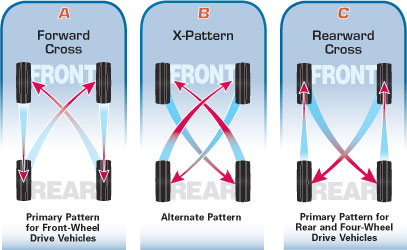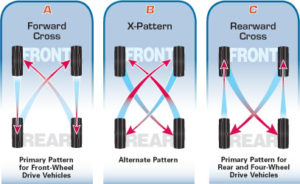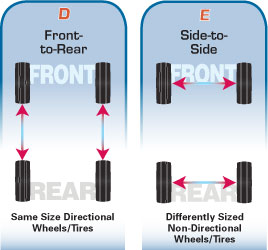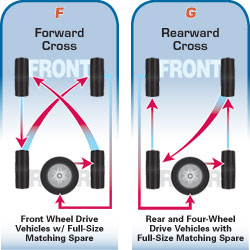When done at the recommended times, tyre rotation can preserve balanced handling and traction, even-out tyre wear and provide performance advantages.
Many tyre warranties require tyre rotation to keep the warranty valid.
Tyre rotation helps even out tyre wear by allowing each tyre to work in as many of the vehicle’s wheel positions possible. Remember, tyre rotation cannot correct wear problems due to worn mechanical parts or incorrect inflation pressures.
Vehicles are typically equipped with 4 tyres, usually the tyres on the front axle need to accomplish very different tasks than the tyres on the rear axle. Tyre wear experienced on a performance vehicle will usually be more severe than that of a family vehicle. Each wheel position can cause different types of tyre wear at different rates.
It is an advantage when all four tyres wear together because as wear reduces a tyres tread depth, it allows all four tyres to respond to a driver’s input more quickly, maintains handling and helps increase the tyres cornering traction.
When your tyres wear out together, you can get a new set of tyres without being forced to buy pairs. If you replace tyres in sets of four, you will maintain the original handling balance. Our suppliers constantly introduce new tyres, each of which improves upon their past product’s performance.
Replace your tyres in sets of four and experience today’s technology to the full!
When should tyres be rotated?
We recommend that tyres are rotated every 3,000 to 5,000 miles. Tyre rotation can be done when a vehicle is taken for a service. This is also a good time to have your tyres rebalanced.
Inspect the tyres for any damage, remove stones or debris from the tyre treads, check for uneven wear by checking the tyre tread depth and check the tyre pressure.
Four Tyre Rotation
What tyre rotation pattern should be followed? The Tyre & Rim Association has identified 3 rotation patterns that cover most vehicles which are equipped with non-directional tyres and wheels of the same size and offset.
- Rearward Cross (Figure C)
- Forward Cross (Figure A)
- X-Pattern (Figure B)
Today’s performance tyre and wheel trends require 2 additional patterns.
The “Front-to-Rear” (Figure D) pattern may be used for vehicles equipped with the same size directional wheels and/or directional tyres.
A “Side-to-Side” (Figure E) pattern may be used for vehicles equipped with different sized non-directional tyres and wheels on the front axle compared to the rear axle.
If these last two patterns do not provide even wear on the tyres, dismounting, mounting and re-balancing will be necessary. Vehicles that use different sized tyres, and/or wheels with different front and rear offsets with directional tyres will require dismounting, mounting and re-balancing to rotate tyres.
Five Tyre Rotation
Many vehicles are equipped with temporary spares that cannot be included in a tyre rotation program. If the vehicle’s spare tyre matches the four tyres on the ground (if non-directional and not branded “for temporary use”), they should be included in the tyre rotation pattern. Follow the vehicle manufacturer’s recommended tyre rotation procedures, or if not available, insert the spare in the right rear position at every rotation. Place the tyre that would have gone to the right rear as the spare until the next tyre rotation.
- Forward cross pattern (Figure F) – for front-wheel drive cars with a full-size matching spare.
- Rearward cross pattern (Figure G) – for rear-wheel or four-wheel drive cars with full-size matching spare.
Five tyre rotation results in equally distributed use that will help maintain equivalent tread depths on all tyres. When applied to many four-wheel drive and all-wheel drive vehicles, it is required to prevent drive-line damage if a flat tyre forces a new spare to be put to work with partially worn tyres.



